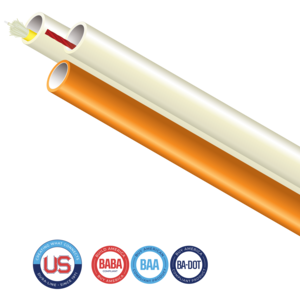Traditional methods like armored cable alone or EMT mean each MAC in your network will include the same set of challenges and costs in time, and money. Because enterprise MicroDucts provide additional capacity as well as protection for your current and future fiber, once they’re in place, your network can evolve seamlessly with minimal cost, time, and administration.
With these additional pathways in place, you also can be confident that as demand increases within your network, MACs will be straightforward and fast – any additional fiber can be jetted in quickly with compact machines the size of a handheld power drill. And as cables continue to become more fiber-dense, your excess pathways will be able to accommodate even more future capacity.
The flexibility of Enterprise MicroDucts provides the option to route cables all the way to the rack within a server room, meaning seamless end-to-end jetting. In a MicroDuct, your cables can also be removed and rerouted easily whenever needed.
Challenges of Armored Cable
If you decide to deploy cable alone, any future MACs will mean you’ll have to navigate the same rights-of-way every time to avoid creating disruption to the operations of your facility. Armored cable, due to its composition, also comes with some specific challenges in enterprise settings:
- Difficult mid-span cable access, which mean each drop presents a real risk of damage to your fiber
- Superfluous fiber termination and testing if you don’t plan to use everything at the beginning
- Precarious re-entry in tight spaces behind wall pathways or channels, including ventilation spaces
In a behind-the-wall setting, armored cable-only also lacks the extra layer of protection that conduit provides, which can mean significant increases in disruption and downtime to your network in the event of a fire.
Challenges of Traditional EMT
It is also possible to install traditional cable in electrical metal tubing (EMT), but this comes with several disadvantages that could end up quickly increasing the budget of your build or upgrade.
Hard metal tubing sounds like a strong protective environment for your cables, but they’re often more costly, time consuming, and take up a lot of space. Because of their material, EMT pathways tend to be:
- Inflexible, which means more joints, and fewer options for MACs
- Corrosive – you’ll need to pay close attention to the condition of your EMT in humid environments
- Limited in capacity, which constrains your options for MACs when connectivity demand increases
- Conductive, which presents a serious electrification hazard if any nearby wiring becomes exposed
Real-World Example of the Benefits of MicroTechnology
In their new hospital build, our customer considered traditional armored cable pathways protected with EMT versus building with MicroTechnology. For the same connectivity requirements, switching to MicroTechnology reduced their costs by 33%.
Not only did this decision reduce our customer’s rights-of-way burden and provide additional protection from electrification and fire and smoke, the Enterprise MicroDucts they installed leaves them with ample spare capacity for future MACs – and direct pathways to jet fiber precisely where they need it within the hospital.
If you’re ready to learn more about how MicroTechnology can bring these benefits to your enterprise network build or upgrade , download our Enterprise End to End Solutions brochure here, and check out our recent webinar in partnership with Corning at their Smart Building Power Hour Series.






